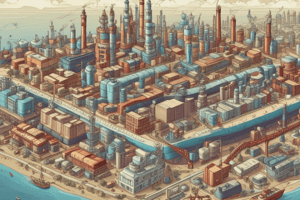Podcast
Questions and Answers
Which classification method categorizes industries based on the oscillations in the economy?
Which classification method categorizes industries based on the oscillations in the economy?
- Input based classification
- Group of industries
- Classification by business cycle (correct)
- Classification by reporting agencies
What is a defining characteristic of growth industries?
What is a defining characteristic of growth industries?
- Their growth rate does not exceed the economy's average
- They grow consistently with high rates of earnings (correct)
- They focus on maintaining current market share
- They typically experience declining earnings
Which stage of the industry life cycle is characterized by low demand and the development of brand differentiation?
Which stage of the industry life cycle is characterized by low demand and the development of brand differentiation?
- Rapid growth stage
- Maturity stage
- Pioneering stage (correct)
- Declining stage
Which industry group includes pharmaceuticals and chemical products?
Which industry group includes pharmaceuticals and chemical products?
What is the primary focus of the rapid growth stage in the industry life cycle?
What is the primary focus of the rapid growth stage in the industry life cycle?
Which types of industries have a significant capital base and can be listed on a stock exchange?
Which types of industries have a significant capital base and can be listed on a stock exchange?
In which stage are companies most likely to experience strong growth in market share and financial performance?
In which stage are companies most likely to experience strong growth in market share and financial performance?
What is one of the main challenges faced during the pioneering stage of an industry?
What is one of the main challenges faced during the pioneering stage of an industry?
What is a key characteristic of the maturity or stagnation stage of an industry?
What is a key characteristic of the maturity or stagnation stage of an industry?
Which of the following factors can negatively impact the ability of an industry to grow?
Which of the following factors can negatively impact the ability of an industry to grow?
What is a characteristic of the declining stage in an industry?
What is a characteristic of the declining stage in an industry?
What does permanence refer to in industry analysis?
What does permanence refer to in industry analysis?
Which factor is NOT a key consideration when analyzing competitive conditions in an industry?
Which factor is NOT a key consideration when analyzing competitive conditions in an industry?
When analyzing past sales and earnings performance, what aspect is NOT typically considered?
When analyzing past sales and earnings performance, what aspect is NOT typically considered?
What is one of the barriers to entry in an industry related to product differentiation?
What is one of the barriers to entry in an industry related to product differentiation?
Which condition is an essential element for analyzing security risk and return in an industry?
Which condition is an essential element for analyzing security risk and return in an industry?
What is the significance of analyzing revenue growth in a financial analysis?
What is the significance of analyzing revenue growth in a financial analysis?
Which statement accurately describes the purpose of analyzing Balance Sheets?
Which statement accurately describes the purpose of analyzing Balance Sheets?
What are the three activities that should be analyzed in Cash Flow Statements?
What are the three activities that should be analyzed in Cash Flow Statements?
Why is it important to analyze qualitative factors when evaluating a company?
Why is it important to analyze qualitative factors when evaluating a company?
What is the primary goal of company analysis for an investor?
What is the primary goal of company analysis for an investor?
What is a common expectation for smaller companies compared to larger ones?
What is a common expectation for smaller companies compared to larger ones?
Which industry is more flexible in changing prices due to fewer competitors?
Which industry is more flexible in changing prices due to fewer competitors?
What characterizes the top-down approach in company analysis?
What characterizes the top-down approach in company analysis?
What is typically the first step in evaluating a company's fundamentals?
What is typically the first step in evaluating a company's fundamentals?
What does the bottom-up approach prioritize during company analysis?
What does the bottom-up approach prioritize during company analysis?
Which document is essential for analyzing a company's financial position?
Which document is essential for analyzing a company's financial position?
Why might FMCG companies face challenges in changing their prices?
Why might FMCG companies face challenges in changing their prices?
To gain insights about a company like Dabur, which section should be initially referenced?
To gain insights about a company like Dabur, which section should be initially referenced?
What is the significance of economies of scale for established firms?
What is the significance of economies of scale for established firms?
What does a SWOT analysis assess for an investor?
What does a SWOT analysis assess for an investor?
Why is company analysis crucial for stock selection?
Why is company analysis crucial for stock selection?
Which step is NOT part of the company analysis process?
Which step is NOT part of the company analysis process?
What type of information could you find on a company's website under the 'Products' section?
What type of information could you find on a company's website under the 'Products' section?
What is a common risk that businesses typically face?
What is a common risk that businesses typically face?
What does it mean if the price of securities is high relative to future earnings growth?
What does it mean if the price of securities is high relative to future earnings growth?
What does identifying the closest competitors help with in company analysis?
What does identifying the closest competitors help with in company analysis?
Study Notes
Industry Classification
- Reporting agencies categorize industries (e.g., 32 groups by stock exchanges).
- Business cycle classification groups industries based on economic upswings and downswings (growth, cyclical, defensive).
- Examples of growth industries across different decades: automobiles and airplanes (1920s), photography (1940s), color television and computers (1950s), pharmaceuticals and communication (1960s), software (2000s), cellular, genetic engineering, and environmental management (present).
- Industry groups are categorized by size (small, medium, large scale) based on paid-up capital.
- Specific industry groups include food, beverages, textiles, wood products, leather, rubber, chemicals, non-metallic minerals, basic metals, machinery, and other manufacturing.
Industry Life Cycle
- Pioneering stage: Low demand, focus on brand building and differentiation, high risk.
- Rapid growth stage: Strong market share growth, improved technology and efficiency, dividend payouts, attractive investment opportunity (e.g., software, pharmaceuticals).
- Maturity/stagnation stage: Moderated growth, potential for declining growth, reduced investment opportunities, challenges like high labor costs and technological changes.
- Declining stage: Declining demand and earnings, unattractive investment, potential for capital erosion (e.g., black and white TVs).
Key Characteristics in Industry Analysis
- Past sales and earnings performance: Analyze historical sales, average performance levels, stability, and variability.
- Permanence: Analyze the industry’s product and technological lifespan.
- Government attitude: Consider government policies, concessions, and tax benefits.
- Labor conditions: Evaluate labor requirements, potential labor actions, and associated risks.
- Competitive conditions: Assess barriers to entry, product differentiation, cost advantages, and economies of scale.
- Research and development: Analyze the level of R&D investment.
- SWOT analysis: Evaluate internal strengths/weaknesses and external opportunities/threats.
Company Analysis: Why and How
- Company analysis helps evaluate company performance to select suitable stocks.
- Steps: Identify economic characteristics, analyze products/services (nature, uniqueness, demand, market share), assess risks and concerns (growth potential, competition, pricing pressures).
Company Analysis Methods
- Top-down approach: Macroeconomic analysis first, followed by individual stock selection.
- Bottom-up approach: Individual company analysis first, then portfolio construction.
Evaluating Company Fundamentals
- Business model analysis: Understand raw material sourcing, manufacturing, and distribution.
- Financial analysis: Review profit & loss statements, balance sheets, and cash flow statements.
- Comparative analysis: Compare financial performance year-on-year and against industry players.
- Management assessment: Evaluate management experience and track record.
- Cash flow analysis: Examine cash flows from operating, investing, and financing activities.
- Integrate qualitative and quantitative factors for a comprehensive understanding.
Studying That Suits You
Use AI to generate personalized quizzes and flashcards to suit your learning preferences.
Related Documents
Description
Explore the nuances of industry classification and the life cycle stages that industries go through. This quiz delves into reporting agencies' categorizations, business cycle groupings, and examples of growth industries over the decades. Assess your understanding of industry sizes and the dynamics from pioneering to rapid growth stages.




